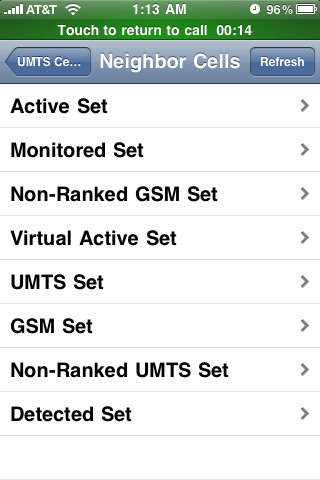AT&T 3G MicroCell: A Comprehensive Exploration
by Brian Klug on April 1, 2010 1:55 AM EST- Posted in
- Smartphones
- AT&T
- Microcell Review
- Mobile
I mentioned earlier that voice and data both work fine, as long as you're inside the MicroCell's coverage radius. So what happens if you step outside? In theory and per advertising, your call is supposed to transition "seamlessly" to the nearest macrosite. In fact, the first time I tried walking out of location 1, it transitioned perfectly! I then proceeded to spend over a half hour trying to repeat my initial success...
The Theory of Handovers
But before I dive into the problems I experienced, let's briefly touch on some of the tech behind it. There are two types of handover that happen on a cellular network: soft and hard handovers. In a soft handover, the phone is continually talking to multiple macrocells at the same time - the transition happens seamlessly because you're already connected and communicating with towers you're going to handover to. This is a make-before-break transition. The transition is simply a matter of choosing which one has the best link quality, and this is generally how most transitions happen because it's robust.
The other case is a hard handover - this is less seamless break-before-make transition that's nearly instantaneous in practice, but still perceptible if you know what to look for. In a hard handover, the phone literally releases its active connection and transitions to another. Also of relevance are so-called vertical handoffs - these are transitions that happen across network technologies, in this case from UMTS to GSM, though other cross-technology handovers are possible as well. There's a huge amount of complexity to these systems; effectively handing off users while maintaining voice and data sessions is a challenging multidimensional problem. One that's often taken entirely for granted because of just how well we're used to it working.
So you can imagine my surprise when I discovered that the handover from femtocell back to public 3G wasn't just rough, it's downright crude. First of all, virtually every femtocell handover is of the hard variety, and in practice almost all of the ones I saw were also vertical, from UMTS (3G) to GSM (2G). During that long provisioning process, I mentioned that the femtocell is building a rough list of all the macrocells it can see. Hopefully, it can see a few of both 3G and 2G variety, which it passes onto the phone in the form of a neighbor list. The phone also builds out its own neighbor list, which you can see some of in the Field Trial (*3001#12345#*) dialer application. It's been gimped significantly since the iPhone 2G, but there's still enough here to get the point across:

Neighbor Cells - Just like advertised
Anyhow, when you leave the femtocell's radius, if there's a macrocell in range and your phone can hard handover to it, the call continues. Hopefully this is what happens, otherwise the call drops. Of course, the big caveat here is that if you're installing the femtocell in a place with little to no signal (why it's there in the first place) handover is going to be a difficult prospect. That's why I tried the AT&T MicroCell both in an area with good existing coverage, and one with poor coverage. The results at both were equally disappointing.
AT&T advertises an effective range of 5000 square feet. This seems about right, but it's signal dependent. Location one is just over of 2000 square feet, and continual femtocell coverage barely makes it across two rooms. Location two is effectively 5000 square feet, and femtocell coverage includes the whole house, guest house, and most of both long driveways. Again, this is largely in part because the femtocell is sitting atop existing 3G spectrum - there's no spectrum overlay just for microcells yet. The result is that if signal is bad where you are, your microcell range is larger. Conversely, if signal is already reasonable, you're not going to see more than a room or two of microcell coverage. It's a complex problem akin to the cell breathing phenomenon, and I think AT&T's 3G MicroCell product is doing a lot of ranging at setup.










63 Comments
View All Comments
nimck - Thursday, October 18, 2012 - link
Does anyone know how to configure the Microcell so that it's in a 'Disabled Mode' during certain hours of the day?? I'd like to lessen the radiation emission.lorace - Thursday, June 19, 2014 - link
We got the Microcell from AT&T because of poor signal strength. After it started working we were pleasantly surprised to see that our service bars had increased substantially. Now a new problem. We can't get our phones to transmit or received any picture messages. Anyone have an idea how to solve this problem? We called AT&T tech and they were clueless. lorace1@yahoo.comc21cg - Sunday, February 7, 2016 - link
i have had TWO of these crappy things, been on the phone for 17 months continously with att to get sorry help, have all the light lit up on the cell and NO service... so now what - oh and I even had to upgrade my wifi to satisfy att- hate ATT